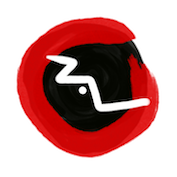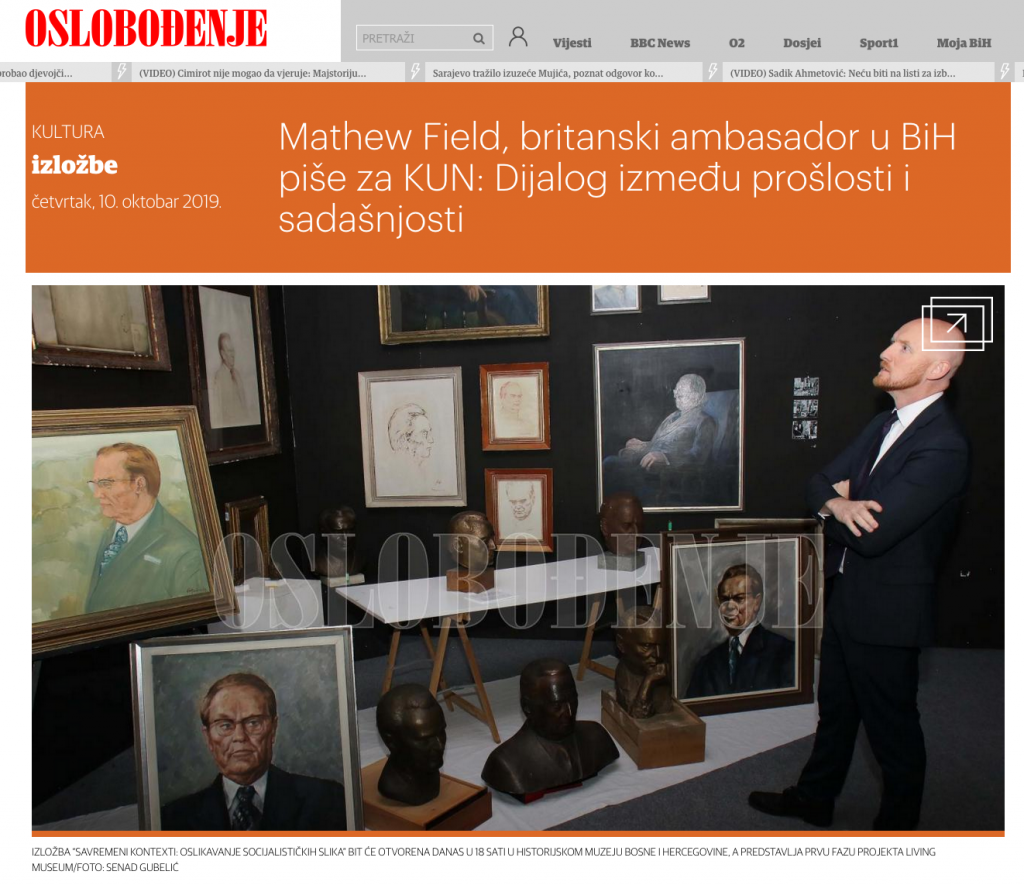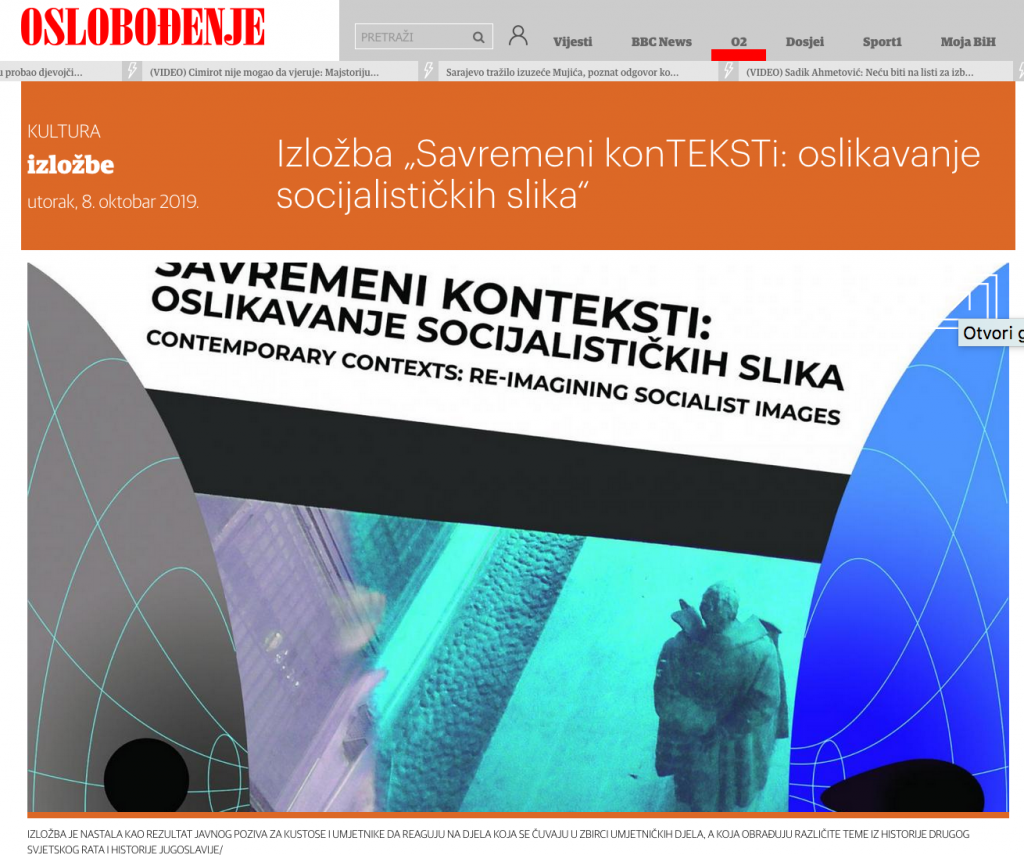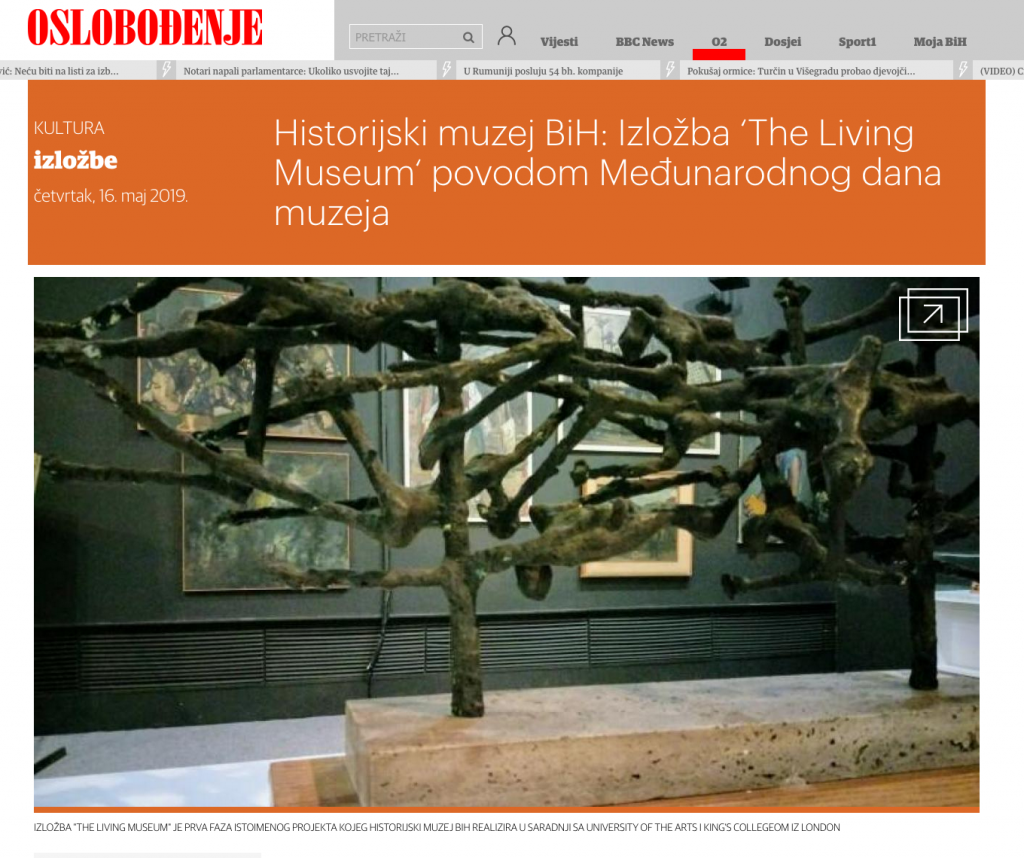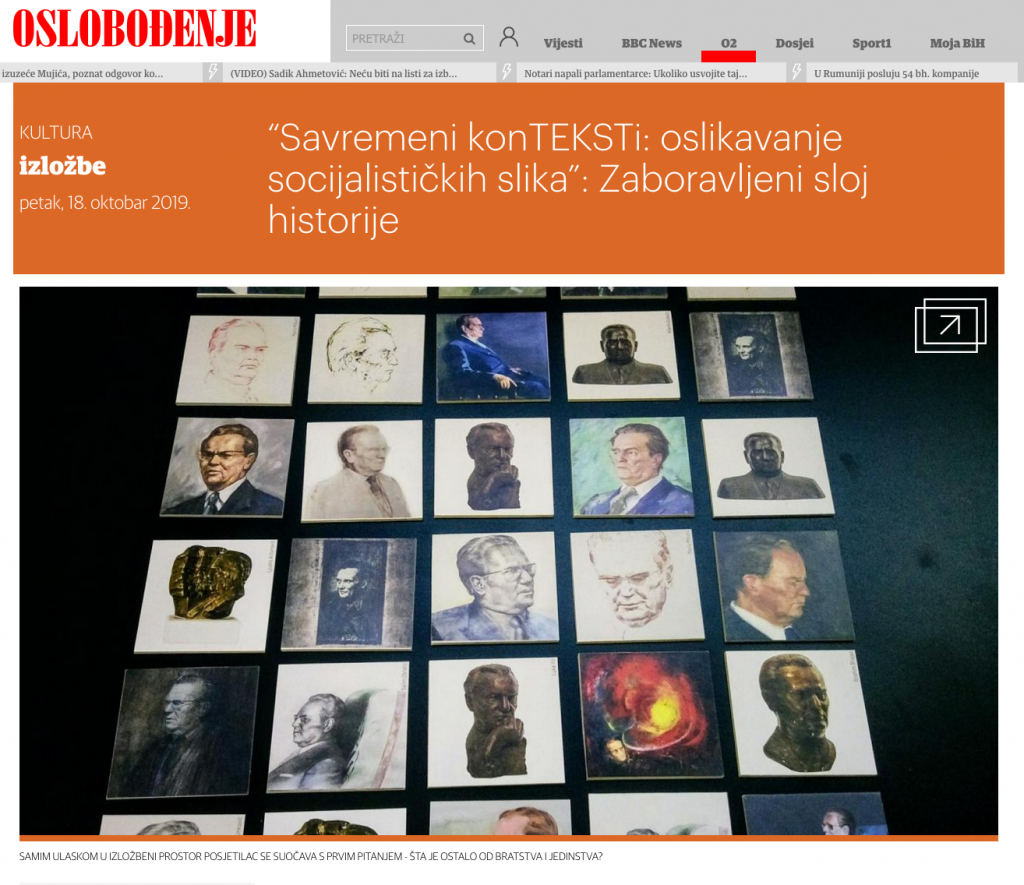Mathew Field, British Ambassador to BiH, writes for KUN: Dialogue between past and present
The History Museum of Bosnia and Herzegovina in Sarajevo is one of my favourite cultural buildings, despite, or perhaps because of, what is often overlooked. Formerly the Museum of the Revolution of Bosnia and Herzegovina, today this building is an orphan amongst other BiH institutions, without the proper support of any level of government, somewhat unloved and certainly left with insufficient resources.
But inside the damaged walls are energy and ideas — everything you would hope to find in a modern museum. This building has hosted some of the most interesting and significant works of art to come to Sarajevo, such as Brian Eno’s brilliant works, last year, and the exhibition “Forgotten Children of War”, or the recent photographic exhibition — a collaboration between Jim Marshall and Matteo Ceschi. The Museum also houses a permanent display, the powerful exhibition on the siege of Sarajevo, and the institution also holds 2,000 works from the period of the Socialist Federal Republic of Yugoslavia.
The Yugoslav heritage
Today, the History Museum opens another exhibition to inspire thought. A few months ago, the Museum, in conjunction with King’s College London and the University of the Arts London, called on artists, curators and lecturers to help find new ways of exploring, responding to and even intervening in the Museum’s Yugoslav collection. By opening up a dialogue between the present time and the past, they wanted to find a new way of looking at the collection, as well as to open up public discussion of what to do with this valuable, but largely unseen, collection.
One of the surprises for the organizers of this open call was the great interest among young people, that is, those with little or no personal experience of life in the former state. This call has also resulted in many different creative approaches, using different techniques and technologies. Five of these works, in dialogue with older exhibits from the collection, will form part of a new exhibition, Contemporary Contexts: Re-Imagining Socialist Images, running from 1st -31st October.
My attention was especially drawn to the work of Dzenan Hadzihasanovic – “Blank Title”, which is a reproduction of a Frane Delale painting of a group of protesters, in which the original political slogans of that time have been replaced by blank slogans and banners. In this way, the work invites us to reflect on our new messages, values or complaints, and on their connection with individuals or groups from an earlier period.
A place for slogans
An exhibition like this is not meant to be a passive experience — what the organizers are hoping for is to catalyze a conversation about what to do with this important part of this country’s history, its heritage, and how to make it relevant to today. Like a picture of people holding blank slogans, the canvas is there — if anyone wants to express themselves.
When I spoke to one of the curators of the exhibition “Contemporary conTEXTS: Re-Imagining Socialist Images,” they told me that this was only the first phase of the Living Museum project and that in the future they hoped for more collaborations, as well as a greater interaction by young artists with this great collection. In short, they want to bring history to the light of day, launch a public debate about it, and bring the Museum to life. I’m excited to see their next move.
(The author is UK Ambassador to Bosnia and Herzegovina)
Exhibition “Contemporary Contexts: Re-Imagining Socialist Images”
Contemporary conTEXTS: Re-Imagining Socialist Images opens at the History Museum of BiH on 10th October at 6 pm. The exhibition is part of ‘The Living Museum’ project, by project partners the History Museum, the University of the Arts London and King’s College London. The project has created a platform for innovative research and intervention in the Art Collection of the History Museum of BiH, a collection formed in Yugoslavia, which has been moved to the central exhibition space for this project.
The exhibition was created as the result of a public call for curators and artists to respond to works kept in the Art Collection, covering various topics from the history of World War II and the history of Yugoslavia. These works have not been presented to the public for almost three decades, even though they were created by the most significant names of the Yugoslav art scene. This summer, artists and curators were given the chance to see the collection, to research and to create in the open museum atelier. The exhibition will feature works by Dzenan Hadzihasanovic, Milena Michalski, Smirna Kulenovic, Melia Teparic and Andrea Mirnic. The transition from one social system to another changed the status of works of art, but also of museum exhibits in general. The History Museum of BiH, formerly the Museum of the Revolution of BiH, examines the changes in society’s attitude towards the legacy of socialism, through this exhibition. Although it is an international project, a large number of local artists responded to the themes of the Collection — and a significant number of young artists will present their works within this project. It was interesting to note what artists responded to most. It was slogans on banners within artworks, and portraits of Josip Broz Tito. The exhibition title was created precisely because of the relationship between the textual and the visual, designed to invite the viewer to participate in the re-interpretation of a particular historical epoch, to portray familiar images in new social contexts.
The exhibition Contemporary Contexts: Re-Imagining Socialist Images is the first in a series of exhibitions to be organized through ‘The Living Museum’ project by the end of the year and will run until 30th October.
Written by: K.R.
Artists at the History Museum have shown why socialism should be protected from oblivion
A joint project of the History Museum of History of BiH, Kings College London and the University of the Arts London, invited artists to respond to the socialist collection. Five young artists have created works that will help raise awareness of this almost forgotten but very important collection that speaks of a different time and system.
Entering the premises of the History Museum of BiH, the visitor is confronted with the first question around which the whole exhibition revolves — what actually happened to Brotherhood and Unity? What remains of socialism and everything created during that period?
The artists Meliha Teparic, Dzenan Hadzihasanovic, Smirna Kulenovic, Andrea Mirnic and Milena Michalski have created five installations, which have been placed in different parts of the room. Each of them sends the same message in a different way and succeeds in getting across to the viewer the importance of this period of history and warning of the dangers of forgetting such things.
“And after Tito – Tito!” Is the title of the work by Smirna Kulenovic. It takes a number of comments from regional portals and feeds them into AttnGAN Artificial Intelligence, a neural network trained on millions of images, to create a mosaic made up of 100 small-format images. Each image is based on comments from users of regional portals regarding current leaders and how people imagine them.
“As we artists were invited to respond to one part of the collection on Yugoslavia, I decided to respond to the gallery of Josip Broz Tito. In those photographs we always see him from the same perspective, from the same angle … and it all says a lot about the period in which the pictures were taken. My work is a contemporary portrait that shows how people today see politicians in power in the current democratic system. This is a collective consciousness, a collective imagination — all that came into being after Tito, “explains Kulenovic.
She adds that the mosaic of hundreds of photographs shows the disappearance of socialism, as well as fewer and fewer traces of Tito. Not only are the traces of socialism lost, she says, but the whole sense of life, which was much stronger in Yugoslavia, when people were happy in the country in which they lived, was lost. ‘The way we see politicians today and the government in general is completely different. We are losing our love for, sense of, desire to stay in, the country in which we live’, she concluded.
Just a few steps away from Smyrna’s corner is a small table where a memory game is set out. It is entitled “Portraits of Tito Bugojno ’77”. It was created by Andrea Mirnic, an artist who found her inspiration in a wall full of portraits of Tito. The whole gallery of his portraits was actually created in 1977 when he posed in front of 14 artists, given the task of portraying Tito in specific ways. From all this, many identical portraits, sculptures and drawings were created.
‘Even though we see Tito’s face daily, we have forgotten about the artists who created all those portraits we see so often. Through this social game that can be played by all generations, people can get to know all these artists who created Tito’s image, in some way. I wanted to revive the memory game, i.e. to breathe new life into these works. All this will go beyond the borders of the museum’, Mirnic points out.
All these works, which are currently on display in the museum and which served as her inspiration, will soon be returned to the museum depot, and who knows when they will see the light of day again, the artist points out.
‘That is why it is important that we have a game like this that will spread knowledge around the world. In addition to these games, there will probably be a book that will talk more about the artists and the art colony of 1977’, says Mirnic.
Finally, we come to the work of Dzenan Hadzihasanovic. We can see two identical scenes on two canvases separated from each other by only a few inches. Visitors to the exhibition thoughtfully view the “Blank Title” display, and the artist explains in detail what it is all about.
‘On the one hand we have a drawing of Frane Delalle’s Protesters, on the other there is my drawing, which has removed the geographical and historical context, thereby inviting the viewer to engage and fill that empty space with his own opinion. The void is not simply a lack of criticism, it simply invites reflection on the context into which we put history and heritage today, both individually and as a society’, says Hadzihasanovic.
We are from that history, says the artist. Its legacy will always be a part of us, whether we like it or not, but the question remains: what is happening to that historical context today, what is truth, and what is manipulation of the masses?
BiH History Museum OF BIH: Exhibition ‘The Living Museum’ on the occasion of International Museum Day
The exhibition ‘The Living Museum’, curated by Svetlana Hadžirovic and Elma Hodzic, will open on May 18th to mark the central activity of the History Museum of Bosnia and Herzegovina on International Museum Day.
According to the History Museum, this exhibition presents works by the most important BiH and Yugoslav artists, from the History Museum of BiH collection. This exhibition has transformed the central Museum space into an open studio.
For ‘The Living Museum’ project we have transferred about 300 works — paintings, sculptures, drawings, tapestries — from the Art collection to the main exhibition space. The aim was to give the impression of a warehouse, organized into specific thematic units to which the works belong. After 30 years, visitors will have the opportunity to see works that were once part of the permanent exhibition of the Museum of the Revolution of BiH, as well as works stored in the depot of the Collection of Works of Art, which are not available to the public, said Svetlana Hadžirović.
In addition to opening up the Collection for New Interpretations, the goal of the BiH History Museum of BiH is to promote the works of art it preserves.
Hadžirović pointed out that the exhibition begins with the first artwork to be acquired by the Museum, by the academic painter Bozidar Jakac from 1943, followed by portraits of Josip Broz Tito from 1977 in Bugojno, depictions of suffering in the Second World War, depictions of the construction of the country after the war, portraits of village life and World War II heroes, as well as drawings from different periods.
The ‘Living Museum’ exhibition is the first phase of a project of the same name, implemented by the BiH History Museum of BiH in collaboration with the University of the Arts London and King’s College London. The aim of the project is to create a platform for innovative research and intervention in the Art Collection of the History Museum of BiH.
This exhibition is accompanied by a public call for artists / curators / researchers to use the museum space as an open art studio, and the works kept in the collection as inspiration and material for their artistic / curatorial research.
‘Contemporary ConTEXTs: Re-imagining Socialist Images’: a forgotten layer of history
The History Museum, in partnership with Kings College London and the University of the Arts in London, made an open call, inviting artists to respond to the Museum’s socialist art collection that had been in store until the call. The identity of the former Museum of the Revolution is reflected clearly in this collection, which had become almost forgotten and, consequently, that identity was also being forgotten. The moment has come to reconsider the connection between past and present, to look at the legacy that, by accident or intentionally, was put to one side and is now viewed either with complete contempt, or with melancholic nostalgia, but not in any as something that is a real part of our past, rather as a period of vacuum, whose events seem to have had no bearing on the present.
Enthusiasm for the Big Illusion — Meliha Teparić
Immediately on entering the exhibition space, the visitor is confronted with the first question – What is left of Brotherhood and Unity? It poses itself as a physical barrier, an artistic solution that challenges the visitor to find an answer through engagement with slogans printed on translucent canvases. The artist worked with museum collections, primarily its art collection, but also with documents preserved there, to find and recover slogans, which were used as propaganda during socialism. Repeated and printed countless times, they signified truth; she takes them out of the context of the peoples’ liberation struggle and puts them into the contemporary context, in which it seems more and more as if we have given up on any struggle. Were these merely empty words, designed to create the illusion of grandeur, accepted enthusiastically by the masses because they had to? Or, was there a genuine belief that it was possible to achieve the kind of world reflected in the propaganda? And, is the denial and negation of that enthusiasm today the very reason why we reject the idea that change is possible and that utopia awaits us?
Blank Title – Dženan Hadžihasanović
Slogans once again in public after decades are replaced by non-existent ones. Referring to the drawing of Frane Delalle’s Demonstrators, the artist in his version paints on a canvas the same size as the original, by removing the geographical and historical context, invites the viewer to engage and to fill the empty space with their own idea. The void is not simply the absence of criticism, it demands reflection about the context in which we situate history and heritage today, both as individuals and as a society. We are products of that history, a heritage that will always be a part of us, whether we like it or not, but the question is what is happening with that historical context today, what is truth, and what is manipulation of the masses? Does the space for expression of free opinion give room for false interpretations of history? And who is responsible for truth?
And after Tito – Tito! — Smirna Kulenović
What if we found a way in which we did not have to justify our thinking, ethically nor morally? The comment sections of regional websites producing news on political developments are a haven for the free expression of opinion without any consequence. This offers artist Smirna Kulenović perfect terrain to experimentally explore the collective imagination of the image of current political leaders, which is diametrically opposed to the one that had force in the time of socialism, where Tito was represented in a specific way, which he alone could dictate. Using AttnGAN Artificial Intelligence, a neural network trained on millions of images, to generate a text-based image, the artist has created a mosaic, comprising 100 small-format images, each based on user comments from those portals, relating to current leaders and the way people imagine them. This is the first time that an author from Bosnia and Hercegovina has exhibited work that uses this technology, thus creating a new surrealist representation that responds to the surrealism of the current political situation, but even more to the surrealism of transitory perceptions that the transition to democracy and capitalism brings.
Portraits of Tito Bugojno ’77 — Andrea Mirnić
Also inspired by the walls of the museum, which are saturated with portraits of Tito, is a memory game, made up of 40 cards with 20 pairs. During an art camp that was organised in Bugojno in 1997, Tito posed in front of 14 artists, each summoned with the task of portraying Tito’s face, following particular instructions. This resulted in paintings, sculptures and drawings that are actually very similar. This is a perfect fit for the concept of this game. What really intrigued the artist was that, while we still remember and encounter these representations of Tito, we have really forgotten the artists behind them. Thus, this memory game transforms, on the back of the cards, into a puzzle with a photo of each of these artists in the process of creating, which is educational for both children and adults. Also, it opens up a field for reflection about how much we actually forget the background that gave the foundation for that which remains represented in our memory. Completely by chance, or carefully planned?
Tito Through Time and Developing Image — Milena Michalski
This installation consists of reproductions of photographs, both from the museum’s archives, whose negatives have been kept in the depot for years, and made by the artist herself while exploring the museum’s space. It examines the relations of diametrical opposites, asking questions, on which the artist herself reflected during her work in the Museum’s darkroom. How much does a change of context lead to a change in interpretation? This relates not only to documentary and propaganda photographs that are transformed into art-forms, but also to the context of the museum itself, which underwent transition from what was the Museum of the Revolution to what is now called the Historical Museum. Likewise, the archive, which is passive, takes on an active role and opens up a space for reinterpretation. In the same way, through artistic interventions in the printing of photographs, some of which are developed as positives and some as negatives, with deliberate variations in their quality, the artist examines the metaphorical positive and negative aspects of society. In the course of her research, the artist also comes across a photograph of Tito’s little-known son from his first marriage, one that took place before he became such a famous political figure, and whose story is completely contrary to the image that Tito later projected. This leads to the work Developing Image, which again questions the relationship between truth and perception, i.e., the manipulation of perception.
IMAGE CAPTION: Immediately on entering the exhibition space, the visitor is confronted with the first question – What is left of Brotherhood and Unity?
IMAGE CAPTION: Smirna Kulenović is the first BiH artist to show a work based on artificial intelligence AttnGAN
